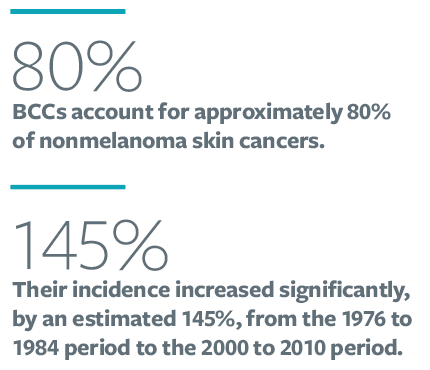- Case-Based Roundtable
- General Dermatology
- Eczema
- Chronic Hand Eczema
- Alopecia
- Aesthetics
- Vitiligo
- COVID-19
- Actinic Keratosis
- Precision Medicine and Biologics
- Rare Disease
- Wound Care
- Rosacea
- Psoriasis
- Psoriatic Arthritis
- Atopic Dermatitis
- Melasma
- NP and PA
- Skin Cancer
- Hidradenitis Suppurativa
- Drug Watch
- Pigmentary Disorders
- Acne
- Pediatric Dermatology
- Practice Management
- Prurigo Nodularis
- Buy-and-Bill
Publication
Article
Dermatology Times
Frontline Forum Part 1: Improving Basal Cell Carcinoma Management
Author(s):
In part 1 of this Frontline Forum series, Brent Moody, MD; Sarah Arron, MD, PhD; Justine Cohen, DO; Emily Ruiz, MD, MPH; and Todd Schlesinger, MD, discuss non-surgical treatment options for the management of BCC, dose adjustments for systemic treatments, combining hedgehog pathway inhibitors with immunotherapy, and more.

“A lot of our colleagues in practice still have a lot of gaps in their understanding of systemic therapies for basal cell carcinoma [BCC],” said Brent Moody, MD, to kick off the discussion surrounding the improvement of BCC management. “I think particularly in the Mohs surgery community that was unmasked in the recent board exams.”
BCCs account for approximately 80% of nonmelanoma skin cancers.1 Their incidence increased significantly, by an estimated 145%, from the 1976 to 1984 period to the 2000 to 2010 period.2 Although mortality associated with BCC is very low (< 0.1%), untreated disease can spread locally and cause significant cosmetic and functional morbidity, particularly because many BCCs are located on the face.3 In the Dermatology Times Frontline Forum custom video series “Expert Perspectives in the Management of Basal Cell Carcinoma,” moderated by Moody, panelists discussed the importance of a multidisciplinary team for advanced BCC, management strategies for real-world clinical cases in their respective practices, and potential opportunities to enhance options for systemic treatment of BCC.
Identifying Root Causes of Delays in Care
Schlesinger noted that nonsurgical treatment options are particularly important for patients who present with tumors that are too advanced for curative surgery, often because of difficulties in seeking early treatment or reluctance to do so. Additionally, identifying the reason for the delay in diagnosis (eg, lack of insurance or access to care, mistrust of doctors, or denial about the extent of disease) is important to consider when developing treatment strategies for these patients, said Sara Arron, MD, PhD. In some cases involving a patient who is initially reluctant to pursue surgery and the availability of multiple acceptable treatment approaches, Arron starts with a systemic therapy while building the patient’s trust. This is followed by surgery as the patient becomes more accepting of treatment.
“There’s a difference between a patient who has a delay in care because they don’t want to seek care versus a delay in care because of our health care system,” said Arron. “I try to explore that with the patient because it can help me get to the root of their motivation for treatment.”
Having a multidisciplinary team that collectively performs various assessments and imaging is important for determining the overall treatment strategy for advanced BCC, which is highly individualized and should involve patient input. Schlesinger and Nathalie Zeitouni, MD, noted that prompt and effective communication with other members of the multidisciplinary team, such as the radiation oncologist and medical oncologist, is especially important when referring patients in a private practice setting.
“If I have a patient [who] is coming to me for surgery, it’s an advanced case, it’s not resectable, I’ll sit down with [the] patient and I’ll go, ‘This is why I think in my hands, I wouldn’t be able to resect it, I wouldn’t be able to get clear margins, we don’t want this coming back,’” said Zeitouni. Then she initiates a discussion of colleagues who might be able to further support the patient. She tells the patient, “I just want you to see our medical oncologist or even a surgical oncologist or a radiation [oncologist], and I’m going to call them right away. At that point, I don’t get that much resistance when I actually explain the process.”

Over the past 10 years, dermatologists in community practice have become increasingly knowledgeable about nonsurgical options for patients with advanced BCC. However, developing the multidisciplinary networks among providers within a community setting needs further improvement, said Arron. Emily Ruiz, MD, MPH, added that many patients with BCC become lost to follow-up after their initial treatment because none of the clinicians have taken the lead through the surveillance period. She noted that community dermatologists should be the ones to coordinate that multidisciplinary care and follow-up in most cases.
The seriousness of BCC may also be underestimated by nondermatologist general practitioners, which may lead to patients returning with advanced disease after being undertreated for their initial presentation, said Schlesinger. Patients previously diagnosed and treated for BCC may also underestimate the importance of follow-up, and a lack of a structured surveillance program for patients previously treated for BCC further decreases the likelihood that they will seek additional treatment for disease progression or recurrence. Zeitouni noted that patients can also get lost in the system if a referring physician does not give them a specific doctor or center to follow up with.
References
1. American Cancer Society. Key statistics for basal and squamous cell skin cancers. Updated January 12, 2023. Accessed July 21, 2023. https://www.cancer.org/cancer/types/basal-and-squamous-cell-skin-cancer/about/key-statistics.html
2. Muzic JG, Schmitt AR, Wright AC, et al. Incidence and trends of basal cell carcinoma and cutaneous squamous cell carcinoma: a population-based study in Olmsted County, Minnesota, 2000 to 2010. Mayo Clin Proc. 2017;92(6):890-898. doi:10.1016/j.mayocp.2017.02.015
3. Flohil SC, Seubring I, van Rossum MM, Coebergh JW, de Vries E, Nijsten T. Trends in basal cell carcinoma incidence rates: a 37-year Dutch observational study. J Invest Dermatol. 2013;133(4):913-918. doi:10.1038/jid.2012.431






